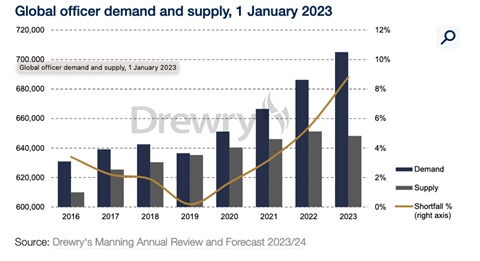Officer supply shortfall has reached a record high and is not expected to improve, leading to manning cost inflation, according to the latest Manning Annual Review and Forecast report published by shipping consultancy Drewry.

The 2023 officer availability gap has widened to a deficit equating to about 9 percent of the global pool, which represents a marked rise from last year’s 5 percent shortfall and the highest level since Drewry first started analysing the seafarer market 17 years ago. Similar deficit levels are forecast for 2023-2028.
“While these deficit levels are based on vessel numbers together with assumptions on crewing levels and so largely theoretical, they clearly indicate that the seafarer labour market has become particularly tight, with important implications for recruitment and retention as well as manning costs,” said Drewry. It added that the effects of Covid-19 are still persistent, as it not only had a substantial impact on crew training but also on the overall appeal of working at sea. This was mainly due to the various stories of crews stuck on board vessels, too often in dire conditions.
As a result, the analyst believes that importance of wellbeing has come to the forefront in employee retention, and the trend of looking beyond wage rates is becoming stronger by the day. Things like good communication channels with families at home, comfortable facilities onboard and a supportive work environment are gaining importance. The eruption of the Russia-Ukraine war created further challenges in seafarer supply, with many experienced crews returning home to join the military. Unfortunately, there is no end in sight to the war currently, so we expect numbers of new seafarers from Russia and Ukraine to be very limited for a while, it added. While vessel manning will be challenging over the few next years, especially with regard to officer availability because of these issues, the accelerating growth of the global deep sea vessel fleet will make the situation even more difficult.
“Employers are seeking alternative sources of supply to fill the gap, and wages have also begun to show more volatility,” said Drewry’s head of manning research Rhett Harris. “While sectors like containerships and offshore supply vessels have already seen increasing wage rates due to the strength of the sectors, we expect wage cost to accelerate for other vessel types as well.”
















